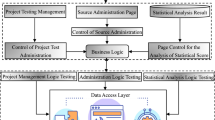Abstract
The sports decision-making system is affected by many factors, and the sports decision-making system itself is a complex decision-making system, including multiple micro-systems. In order to construct a more scientific sports decision-making model, this paper builds a sports decision-making model based on data mining and neural network based on data mining technology and neural network algorithms. Moreover, based on the analysis of system theory, stakeholder theory and multi-objective decision-making theory, this paper provides a theoretical basis for the study of multi-objective decision-making problems in sports events. In addition, this paper discusses the starting point of decision-making and the scope of research from the basic concepts of sports decision-making and analyzes the multi-objective decision-making system of sports decision-making. At the same time, on this basis, this paper designs a multi-objective decision-making model for sports events, and finally conducts empirical research based on the designed model. Through empirical analysis and simulation research, it can be known that the combined model constructed in this paper performs well and has certain practical effects.












Similar content being viewed by others
References
Keating XD (2017) Research on preservice physical education teachers’ and preservice elementary teachers’ physical education identities: a systematic review. J Teach Phys Educ 36(2):1–29
Yli-Piipari S (2014) Physical education curriculum reform in Finland. Quest Ill Natl Assoc Phys Educ Higher Educ 66(4):468–484
Landi D, Fitzpatrick K, Mcglashan H (2016) Models based practices in physical education: a sociocritical reflection. J Teach Phys Educ 35(4):400–411
Erfle SE, Gamble A (2015) Effects of daily physical education on physical fitness and weight status in middle school adolescents. J Sch Health 85(1):27–35
Cheon SH, Reeve J, Yu TH et al (2014) The teacher benefits from giving autonomy support during physical education instruction. J Sport Exerc Psychol 36(4):331–346
Bendiksen M, Williams CA, Hornstrup T et al (2014) Heart rate response and fitness effects of various types of physical education for 8- to 9-year-old schoolchildren. Eur J Sport Sci 14(8):861–869
Hollis JL, Williams AJ, Sutherland R et al (2015) A systematic review and meta-analysis of moderate-to-vigorous physical activity levels in elementary school physical education lessons. Prev Med 86(1):34–54
Wang JCK, Morin AJS, Ryan RM et al (2016) Students’ motivational profiles in the physical education context. J Sport Exerc Psychol 38(6):612–630
Fletcher T, Casey A (2014) The challenges of models-based practice in physical education teacher education: a collaborative self-study. J Teach Phys Educ 33(3):403–421
Oudah A (2014) The nature of personal characteristics of the teaching faculties of physical education in the southern region from the view of their students. Phys D-Nonlinear Phenom 26(1–3):181–192
Aelterman N, Vansteenkiste M, Lynn VDB et al (2014) Fostering a need-supportive teaching style: intervention effects on physical education teachers’ beliefs and teaching behaviors. J Sport Exerc Psychol 36(6):595–609
Goossens L, Verrelst R, Cardon G et al (2014) Sports injuries in physical education teacher education students. Scand J Med Sci Sports 24(4):683–691
Lander N, Eather N, Morgan PJ et al (2017) Characteristics of teacher training in school-based physical education interventions to improve fundamental movement skills and/or physical activity: a systematic review. Sports Med 47(1):135–161
Sun H, Li W, Shen B (2017) Learning in physical education: a self-determination theory perspective. J Teach Phys Educ 36(3):277–291
Lewis K (2014) Pupils’ and teachers’ experiences of school-based physical education: a qualitative study. Bmj Open 4(9):e005277–e005277
Viciana J, Mayorga-Vega D (2016) Innovative teaching units applied to physical education—Changing the curriculum management for authentic outcomes. Kinesiology 48(1):142–152
Scrabis-Fletcher K, Rasmussen J, Silverman S (2016) The relationship of practice, attitude, and perception of competence in middle school physical education. J Teach Phys Educ 35(3):241–250
Hastie PA, Wallhead T (2016) Models-based practice in physical education: the case for sport education. J Teach Phys Educ 35(4):390–399
Glazier PS, Mehdizadeh S (2019) Challenging conventional paradigms in applied sports biomechanics research. Sports Med 49(2):171–176
Mullen T, Highton J, Twist C (2015) The internal and external responses to a forward-specific rugby league simulation protocol performed with and without physical contact. Int J Sports Physiol Perform 10(6):746–753
Appelbaum LG, Erickson G (2018) Sports vision training: a review of the state-of-the-art in digital training techniques. Int Rev Sport Exerc Psychol 11(1):160–189
Rein R, Memmert D (2016) Big data and tactical analysis in elite soccer: future challenges and opportunities for sports science. SpringerPlus 5(1):1–13
Ridderinkhof KR, Brass M (2015) How kinesthetic motor imagery works: a predictive-processing theory of visualization in sports and motor expertise. J Physiol Paris 109(1–3):53–63
Mulligan D, Lohse KR, Hodges NJ (2016) An action-incongruent secondary task modulates prediction accuracy in experienced performers: evidence for motor simulation. Psychol Res 80(4):496–509
Tivener KA, Gloe DS (2015) The effect of high-fidelity cardiopulmonary resuscitation (CPR) simulation on athletic training student knowledge, confidence, emotions, and experiences. Athl Train Educ J 10(2):103–112
Ivashchenko OV, Kapkan OO (2015) Simulation of process of 14–15 years old girls’ training of light athletic and gymnastic exercises. Pedagog Psychol Med Biol Probl Phys Train Sports 8:32–40
Acknowledgements
This research was supported by National Social Science Fund of China (Grant Number17CTY005).
Author information
Authors and Affiliations
Corresponding author
Ethics declarations
Conflict of interest
The authors declared that they have no conflicts of interest to this work. We declare that we do not have any commercial or associative interest that represents a conflict of interest in connection with the work submitted.
Additional information
Publisher's Note
Springer Nature remains neutral with regard to jurisdictional claims in published maps and institutional affiliations.
Rights and permissions
About this article
Cite this article
Yuan, C., Yang, Y. & Liu, Y. Sports decision-making model based on data mining and neural network. Neural Comput & Applic 33, 3911–3924 (2021). https://doi.org/10.1007/s00521-020-05445-x
Received:
Accepted:
Published:
Issue Date:
DOI: https://doi.org/10.1007/s00521-020-05445-x




